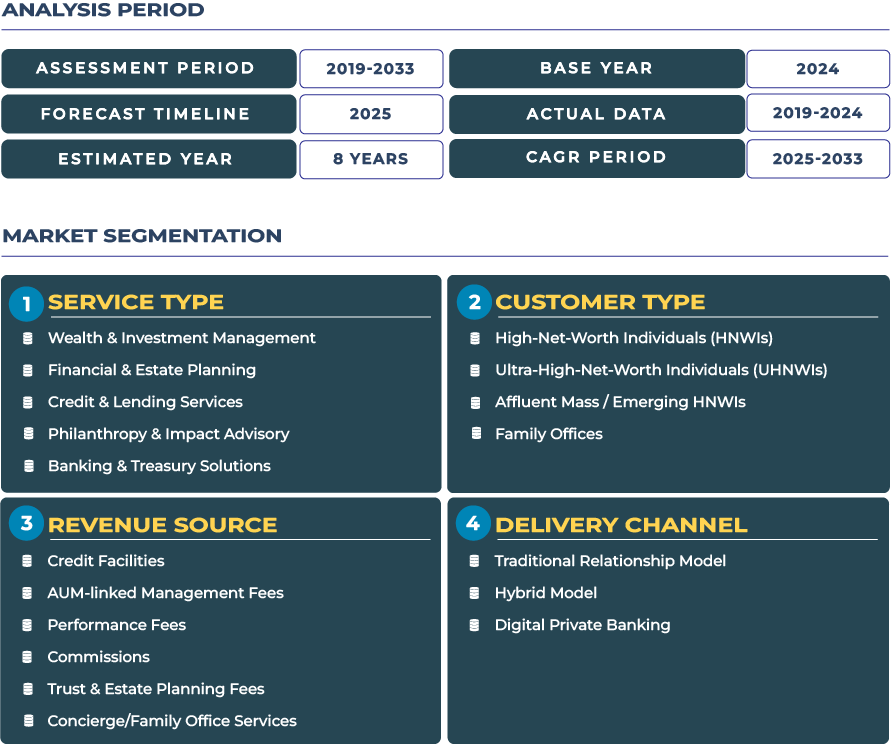Market Outlook: Strategic Growth and Transformation Path for Russia Private Banking Sector Through 2033
Russia private banking market reflects cautious growth balanced by structural opportunity. Forecast to expand from USD 19.4 billion in 2025 to approximately USD 23.3 billion by 2033-with a CAGR of about 2.3%-the market’s size may be modest but its strategic potential is meaningful. The moderate growth signal suggests that the primary driver will not simply be incremental client acquisition but deeper client-lifecycle monetisation, improved wealth-structuring services, and cross-border capital choreography.
Note:* The market size refers to the total revenue generated by banks through various services.
The performance of this market is supported by Russia significant pool of high-net-worth individuals, many of whom seek private banking solutions that extend beyond domestic boundaries. For instance, firms such as Gazprombank have entire private banking divisions expressly designed for HNWIs, addressing investment solutions, deposits, insurance, lending and offshore structuring. However, sanctions, capital-flow restrictions and currency pressures continue to present headwinds. Consequently, successful private banking firms in Russia will need to adopt international advisory frameworks, currency-hedged offerings, and robust compliance platforms to capture value in the forecast period.
Growth Catalysts & Structural Impediments: Forces Shaping Russia Private Banking Industry
Several structural factors provide a foundation for Russia private banking market growth. First, the country’s wealth base derived from commodities and entrepreneurial exits creates a disposable capital pool seeking sophisticated private banking. Second, the increasing imperative for diversification and wealth defence among Russian HNWIs drives demand for global custody, cross-border advisory, and sophisticated estate planning. Studies have shown that Russian wealth possessors are shifting priorities from short-term accumulation to longer-term diversification. Third, as private banks develop more robust lending, treasury and investment infrastructure, opportunities open for credit & lending services and mobile wealth platforms tailored to affluent clients.
Despite these catalysts, numerous headwinds restrain the market’s broader expansion. The sanctions regime, particularly since 2022, has limited access to international capital markets and created barriers for many Russian private banks in offering globally integrated services. Capital restrictions and export controls increase complexity and cost for wealth managers. Currency devaluation and ruble volatility add risk to asset portfolios and favour hedged or offshore solutions-raising cost-to-serve. Moreover, inconsistent regulatory frameworks, varying regional jurisdictions and limitations on foreign advisory complicate scaling of private banking services. Together, these factors help explain the modest 2.3% CAGR projected for the market.
Trend-Vectors & Opportunity Frames: Digital Wealth Engagement, Family-Office Expansion and Onshore Structuring in Russia Private Banking Market
The Russian private banking market is witnessing several emerging trend-vectors. One is the rise of domestic wealth-booking: given international sanctions and capital-outflow deterrents, many HNWIs are opting to domicile assets locally while structuring globally. Private banks are enhancing domestic platforms accordingly. Another trend is crypto-wealth migration: Russian wealthy clients increasingly explore digital-asset holdings, tokenised instruments and blockchain-enabled treasury services-a reflection of technological adaptation amid capital-control pressures. A third trend is the growth of family-office networks: wealthy Russian families are institutionalising governance, philanthropy and multi-generational planning with private banks offering targeted advisory services.
Several clear opportunities exist for private banks operating in Russia. First, on-shore wealth services: banks can capitalise on clients who prefer domestic booking but global advisory by creating hybrid on-shore/off-shore models. Second, offerings tied to the digital ruble and associated treasury/wealth services-private banks that build expertise in blockchain-enabled tools, digital currency custody and ruble-hedged structures will differentiate. Third, family-office network expansion: as generational wealth transitions take place, private banks that deliver full-spectrum services-wealth & investment management, estate planning, credit/lending, philanthropy and treasury-will capture wallet share. In a market where growth is measured, these opportunity frames may deliver disproportionate value.
Competitive Landscape: Strategic Repositioning in Russia Private Banking Market for High-Net-Worth Clients
The competitive dynamics of Russia private banking market are evolving as institutions adapt to the realities of capital-mobility constraints and global wealth shifts. Gazprombank Private Banking, for example, offers sophisticated investment solutions, bespoke lending solutions, art-investment services and international payment/treasury platforms specifically for wealthy families in Russia. Other strategies include localisation of wealth custody, development of niche advisory services, and partnerships with foreign-jurisdiction advisors for cross-border clients capable of mobility. As global firms withdraw or reduce exposure, Russian private banks that can combine domestic strength with global advisory will capture the next wave of affluent clients.







